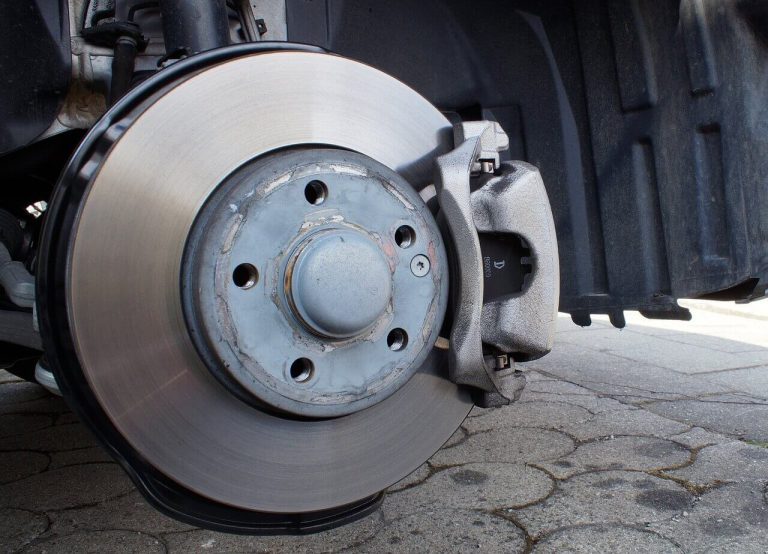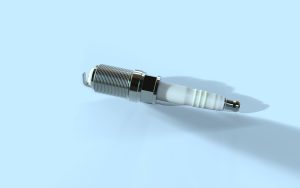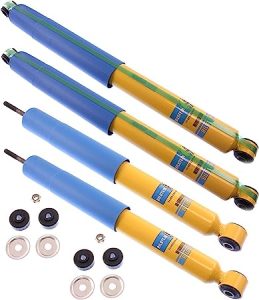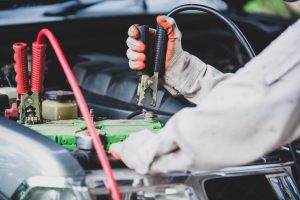Driving with stuck brakes can be an exceptionally dangerous situation and one that needs to be addressed immediately. In my own experience, I had a brake caliper become stuck while out on the road. I knew something was wrong when the pedal began to feel soft and unresponsive. Upon inspecting the car, I noticed that one of the calipers had been seized due to rust and corrosion. With no time to take it to a mechanic, I needed to find a temporary fix until I could get it seen properly. So what is a temporary fix for a stuck brake caliper?
A temporary fix for a stuck brake caliper is a quick and easy repair done to ensure the caliper is freed from its housing and the brake system is filled with fresh fluid so that the car can be safely driven until it can get proper repairs from a certified mechanic. The process involves inspecting the area around the caliper, chipping away at it with a hammer and pliers, replacing the seal around the outer edge of the caliper, tightening up all fastenings surrounding it, and filling up your brake system with fresh fluid.
Table of Contents
ToggleTemporary Fix for Stuck Brake Caliper
You can temporarily fix a stuck brake caliper by using some basic tools. Crawl under the stuck brake caliper side. Cut off the fluid supply to the stuck caliper. After that, remove the bleeder screw and give the caliper’s interior a few good hammer hits. This released the wheel by sufficiently forcing the pistons back into the caliper.
Temporary fixes for stuck brake calipers can be a lifesaver in an emergency when you don’t have access to the right tools or a mechanic. While temporary repairs should never be considered replacements for professional repair work, they can save you time and money while still providing temporary relief from your stuck brake caliper problem.
What is the purpose of Brake Calipers?
Brake calipers are essential components of a vehicle’s braking system. They press against the brake rotors when the brakes are applied, causing friction that slows down the vehicle’s wheels. The pressure generated by the brake caliper is what creates stopping power, so it’s important to make sure they’re functioning properly at all times.
Symptoms of a Stuck Brake Caliper

Graunching Sounds
When your brake calipers get stuck, they can create an unpleasant grinding noise each time you apply pressure to them. This is because they become unable to move freely on their own anymore due to dirt or rust buildup inside of them. Consequently, they end up brushing against other parts of your car, such as the rotor or components within the braking system. Such contact between these pieces causes a grating sound that no driver desires to hear.
Unresponsive Pedal
If you observe your brake pedal is less responsive than usual or feels soft, it might be an indication that the brake caliper has become jammed. This happens when the braking system’s caliper piston becomes stuck in its cylinder due to metal corrosion or dust, causing brake pads and rotors to become permanently engaged and sticking. It pays to be especially vigilant to signs of this problem; having your brakes locked in an engaged state can reduce the effectiveness of your stopping power, putting you and those around you at risk.
Fluid Leakage
Fluid leakage is a key indicator that your brake caliper might be stuck. Maintaining the long-term effectiveness and reliability of your brakes starts with being mindful of any potential indicators that they may be malfunctioning. Keeping a sharp eye out for these warning signs can help preserve your braking system’s performance. When you apply pressure to your brakes, they ensure that you can stop when necessary. Don’t ignore the warning signs, even if slight; fluid leaks around the wheel or near calipers are one of those red flags indicating a possible brake caliper issue. Be sure to inspect any visible wetness on the ground where your vehicle was parked, as this could also be an indication of trouble. It’s always best to take your car for an inspection if you suspect that fluid is leaking from anywhere.
Difficulty Turning Vehicle
If you’re having difficulty turning your vehicle and think it might be a stuck brake caliper, we’ve got the goods! A stuck brake caliper is usually caused when a brake pad gets wedged inside the caliper, restricting movement while braking. While this issue can occur in any type of vehicle, it’s most prevalent among cars with drum brakes. It can also cause your wheels to make a loud noise every time you try to turn them; think of it as your car screaming at you for help! To ascertain if this is appropriate for your circumstances, take a look around the wheel hub and do a visual inspection to check for distractions. If everything looks OK and the noise hasn’t gone away, the only other option is to have your vehicle checked out by an experienced technician.

Vibration or Shaking While Braking
If you’re experiencing a vibrating or shaking sensation when braking your car, it could be a sign that one of your brake calipers is stuck. This happens most often in cases where somebody hasn’t changed their brakes and pads routinely, as faulty brakes can cause the caliper to stick and send unusual vibrations through the brake pedal when applied. It’s important to get this checked out right away because not only will it cause an unpleasant sensation while driving, but it can also wear down other braking system components and cause damage to your vehicle over time. Make sure you take note of these sensations before they develop into something more serious!
Burning Smell Inside Wheels
Getting an unpleasant burning smell while driving isn’t something any of us look forward to. But if it’s inside your wheel, it could be a sign that you need to replace the brake caliper. Brake calipers press against the brakes, creating friction that stops your car, and this friction often causes them to stick, leading to overheated brakes and a burning odor coming from the wheel area. Fortunately, sticking brake calipers can typically be fixed with little hassle; most shops will recommend replacing the old ones and just buying new calipers. But it’s worth getting checked out by a professional as soon as you discover an unfamiliar burning smell — even though it might sound minor, keeping your brakes in top condition is always important for safety!
Also Read: How To Fix Charging Port in Car
Causes of Stuck Brake Calipers
Let’s take a look at the causes of stuck brake calipers and how you can prevent them. Here are some main causes of stuck brake calipers, which I hope will be useful for your prevention and maintenance.

Inadequate Lubrication
Inadequate lubrication is one of the most common causes of stuck brake calipers. This issue occurs when too little grease or brake fluid is used on the pistons and pins, leading to parts being corroded together over time. When this issue is handled promptly, it may be possible to prevent further damage by flushing out the system with either new grease or brake fluid. In some cases, rust buildup may require complete disassembly, cleaning, and re-lubrication of the caliper components, so take special care in inspecting your brakes at regular intervals and be sure not to ignore any signs of inadequate lubrication.
Corrosion from Exposure
Corrosion from exposure is one of the leading causes of stuck brake calipers. Built-up debris such as dirt and sand–along with moisture–can corrode the brake caliper pistons, pins, bores, and fasteners. When corrosion occurs within the pistons, components are unable to move freely, resulting in a reduction in brake performance. Luckily, there are ways to maintain these components to prevent corrosion from occurring and extend the life of your brake calipers. Regularly inspecting your vehicle for signs of wear and tear can help you identify early signs of corrosion that may lead to sticking brake calipers.
Improperly Installed Parts
Brake calipers can be a real nightmare to repair if not installed correctly. All it takes is the wrong torque level, incorrect alignment, and air gaps in the pad presses, and you can end up with a brake caliper that just won’t release. These problems can occur when regular brake pads are replaced and can often happen while trying to install oversized or performance ones. It’s important to research parts thoroughly before committing to them and to make sure all components line up perfectly before fitting to avoid any installation errors which could cause the brakes to stick down. The good news is that once identified, the issue isn’t difficult to solve; just ensure everything is tightened properly and in the right sequence, and place pads carefully so they don’t become blocked by debris. With these steps taken care of, your brakes will release smoothly for years of safe driving.
Leaking Seals/Damaged O-Rings
Brake calipers that get stuck can be a major nuisance. Usually, this issue is caused by leaking seals and damaged o-rings. Without proper sealing, brake fluids can leak out, preventing the brakes of your car from retracting back and creating a feeling of “stuck brakes” when you press on the peddle. In addition to making your ride uncomfortable, this could also reduce your ability to firmly stop your vehicle. If you find yourself in such a predicament, we recommend getting the seals or o-rings checked and replaced at a local mechanic’s shop before jumping straight into replacing the entire brake caliper assembly, as that could end up costing quite a bit more than necessary!
Injury/Misuse of the Vehicle
One common cause of stuck brakes is injury or misuse of the vehicle. Damaging the frame of the car from an accident or hitting a bump too hard can cause problems with the brakes, resulting in them getting stuck. Harsh driving habits like taking sharp turns at high speeds or continually slamming on the brakes can also cause this same issue. While brake calipers do need to be replaced from time to time due to normal wear and tear, it is important to note that improper use can cause them to stick sooner than they would if they were maintained properly. Taking good care of your vehicle and knowing its limits is key to keeping your brakes working optimally.
Brake Hose
When a car’s brakes don’t function correctly, the issue may not always lie with the brake calipers. In some cases, a faulty brake hose is to blame. A brake hose is an important component in a car’s braking system. Over time these hoses can become clogged or brittle making them unable to supply the necessary pressure to engage your car’s brakes. This can lead to reduced response time when applying the brakes and can cause the brake calipers to remain stuck despite attempts to use them. It is essential to address any issues with your car’s brake hose as soon as possible – before it leads to bigger issues like stuck brake calipers!
Grime, Debris, or Rust Residue
Grime, debris, or rust residue can be the underlying cause of brake calipers becoming stuck and not releasing. If your car is exhibiting the signs of brakes not releasing when stepping on the pedal, this is possible that it’s caused by deposits of grime and gunk that have built up over time. Keep in mind while this is an easy fix with a good cleaning procedure, you could run into further issues if any parts were damaged because of such debris. It’s best to tackle the issue early before it turns into something more serious.
How to Do a Temporary Fix For Stuck Brake Caliper
Now that we know what causes a brake caliper to become stuck and why it needs to be fixed let’s get into how to do a temporary fix for a stuck brake caliper. The first step is to identify which wheel has the sticking caliper—in most cases, it will be only one wheel that is affected. Once you’ve identified which wheel has the problem, you can begin the temporary fix by doing the following:
Step 1
Start by checking the brake pads. Make sure that they are aligned properly and that all bolts and nuts are tightened securely. Thoroughly inspect the area for any indications of deterioration or damage that may be causing the issue. If everything looks good, move on to step 2.
Step 2
Take a look at the brake fluid level in your reservoir tank. If it is low, top it up with fresh fluid until it reaches the recommended level. Consult your owner’s manual for the exact amount of fluid to add.
Step 3
Unscrew the caliper bolts from one side of the wheel assembly and remove them carefully. Once this is done, slide each bolt out of its hole and set it aside for later inspection.
Step 4
With both sides of the wheel assembly free from their bolts, take hold of both sides and wiggle them gently but firmly back and forth to loosen them up. This motion should allow you to see if there is anything stuck inside that might be preventing them from moving freely again.
Step 5
Inspect both sides of the wheel assembly closely; look for any signs of rust or corrosion that could be preventing proper movement or causing things to stick together. If you find anything, use some sandpaper or steel wool to scrape away buildup before reassembling everything again with new bolts (if needed).
Step 6
Reattach each side of the wheel assembly using new bolts if necessary, then use a wrench or spanner to tighten each bolt until snug but not too tight, as this can cause further damage down the line.
Step 7
Now fill up your reservoir tank with fresh brake fluid once again until it reaches its recommended level, as noted in your owner’s manual, before moving on to step 8.
Step 8
Open up your master cylinder valve by turning it clockwise, then close it off after about 30 seconds before continuing to step 9.
Step 9
Pump your brakes gently several times until you feel resistance on both sides before going ahead with step 10.
Step 10
Open up your master cylinder valve once again and let out any air bubbles trapped within until only clear fluid comes out without any bubbles present before closing off again once finished.
Considerations when Attempting a Temporary Fix for Stuck Brake Caliper
When attempting a temporary fix for stuck brake calipers, it is important to take the necessary safety precautions to ensure your vehicle remains safe. Here are some tips and warnings to consider when doing a temporary fix:
- Always make sure to wear protective gloves and safety goggles when removing the caliper bolts from the wheel assembly to protect yourself from any sharp edges that may be present.
- Never over-tighten your caliper bolts, as this can cause further damage down the line. It is important to always check their tightness after every few months or so.
- Be sure to check the brake fluid level in your reservoir tank frequently and top it up with fresh fluid when needed.
- If you notice any signs of rust or corrosion on either side of the wheel assembly, clean it off immediately before reassembling everything again.
- Always use a wrench or spanner to tighten each caliper bolt until snug but not too tight to avoid any further damage.
- If you notice any air bubbles present within the brake fluid after opening up your master cylinder valve, be sure to let them out before closing off again.
- Doing a temporary fix for stuck brake calipers is only meant as a short-term solution and should not be a permanent fix. It is important to always take your vehicle to a trusted mechanic for a more thorough inspection if the problem persists.
- Always make sure to follow the instructions in your owner’s manual when topping up with brake fluid and taking other necessary steps, as these will vary depending on the type of car you have.
Following these safety tips and warnings will help ensure that your temporary fix for stuck brake calipers is successful in the short term.
Also Read: Car Overheating Then Going Back To Normal
Frequently Asked Questions
Is it safe to attempt a temporary fix for stuck brake calipers?
Yes, it is possible and safe to attempt a temporary fix for stuck brake calipers, but it should only be used as a short-term solution until you can take your car to a trusted mechanic for further inspection. It is important to always take the necessary safety precautions and be sure to follow the instructions in your owner’s manual when taking any steps, such as topping up the brake fluid.
How do I know if my brake caliper is stuck?
You may notice a decrease in braking power or an increase in stopping distance, as well as hearing unusual noises such as squeals or squeaks when pressing down on the brakes if your vehicle seems to pull to one side while braking. This may also be a sign of a stuck brake caliper.
Can You Drive with a Stuck Brake Caliper?
It is not advisable to drive with a stuck brake caliper, as it can cause damage to other components or even result in an accident. A stuck brake caliper can be dangerous as it impedes the braking power of your vehicle and makes driving difficult. If you are having difficulty getting your brakes to move freely again, it is best to seek professional help.
Can a Stuck Brake Caliper Fix Itself?
In most cases, no, a stuck brake caliper cannot fix itself. A stuck caliper is usually caused by corrosion or rusting of metal parts, and the only way to fix this issue is to take your vehicle to a professional mechanic or use a lubricant to loosen up the stuck components. It is important to keep in mind that even after fixing the problem yourself with a temporary solution, it is best to get your vehicle checked out and inspected by an expert for any further damage which may have been caused.
How Much Is a Brake Caliper?
With the right brake caliper in mind, you must consider your vehicle’s make and model as well as its size. New car parts can range from a wallet-friendly $50 to an outrageous price of over $200 – that’s why it pays to shop around! On top of this, used or refurbished options are also available at discounted prices if you look hard enough.
Conclusion
A stuck brake caliper is an issue that needs to be immediately addressed to ensure the safety of yourself and other drivers on the road. A temporary fix can be attempted, but it should only be used as a short-term solution until you can take your car to a trusted mechanic for further inspection. It is important to always follow the instructions in your owner’s manual when taking any steps, such as topping up brake fluid and taking necessary safety precautions. With proper care, maintenance, and regular checkups, you can make sure that your brakes remain in top condition for many years to come!







